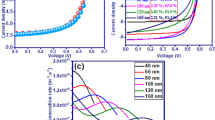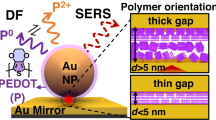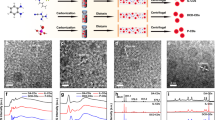Abstract
The coupling of surface plasmons and excitons in organic materials can improve the performance of organic optoelectronic devices. Here, we prepare carbon-dot-supported silver nanoparticles (CD–Ag nanoparticles) using the carbon dots both as a reducing agent and a template to fabricate solution-processable polymer light-emitting diodes and polymer solar cells. The surface plasmon resonance effect of CD–Ag nanoparticles allows significant radiative emission and additional light absorption, leading to remarkably enhanced current efficiency of 27.16 cd A−1 and a luminous efficiency of 18.54 lm W−1 in polymer light-emitting diodes as well as a power conversion efficiency of 8.31% and an internal quantum efficiency of 99% in polymer solar cells compared with control devices (current efficiency = 11.65 cd A−1 and luminous efficiency = 6.33 lm W−1 in polymer light-emitting diodes; power conversion efficiency = 7.53% and internal quantum efficiency = 91% in polymer solar cells). These results demonstrate that CD–Ag nanoparticles constitute a versatile and effective route for achieving high-performance polymer optoelectronic devices.
This is a preview of subscription content, access via your institution
Access options
Subscribe to this journal
Receive 12 print issues and online access
$209.00 per year
only $17.42 per issue
Buy this article
- Purchase on Springer Link
- Instant access to full article PDF
Prices may be subject to local taxes which are calculated during checkout





Similar content being viewed by others
References
Ren, J. et al. Blue (ZnSe) and green (ZnSe0.9Te0.1) light emitting diodes. J. Cryst. Growth 111, 829–832 (1991).
AbuShama, J. A. M. et al. Properties of ZnO/CdS/CuInSe2 solar cells with improved performance. Progr. Photovolt. Res. Appl. 12, 39–45 (2004).
Britt, J. & Ferekides, C. Thin-film CdS/CdTe solar cell with 15.8% efficiency. Appl. Phys. Lett. 62, 2851–2852 (1993).
Kim, J. Y. et al. Efficient tandem polymer solar cells fabricated by all-solution processing. Science 317, 222–225 (2007).
He, Z. et al. Enhanced power-conversion efficiency in polymer solar cells using an inverted device structure. Nature Photon. 6, 591–595 (2012).
Liang, Y. et al. For the bright future—bulk heterojunction polymer solar cells with power conversion efficiency of 7.4%. Adv. Mater. 22, E135–E138 (2010).
Dou, L. et al. Tandem polymer solar cells featuring a spectrally matched low-bandgap polymer. Nature Photon. 6, 180–185 (2012).
Small, C. E. et al. High-efficiency inverted dithienogermole-thienopyrrolodione-based polymer solar cells. Nature Photon. 6, 115–120 (2012).
Choi, H. et al. Combination of titanium oxide and a conjugated polyelectrolyte for high-performance inverted-type organic optoelectronic devices. Adv. Mater. 23, 2759–2763 (2011).
Kulkarni, A. P., Noone, K. M., Munechika, K., Guyer, S. R. & Ginger, D. S. Plasmon-enhanced charge carrier generation in organic photovoltaic films using silver nanoprisms. Nano Lett. 10, 1501–1505 (2010).
Kumar, A., Srivastava, R., Tyagi, P., Mehta, D. S. & Kamalasanan, M. N. Efficiency enhancement of organic light emitting diode via surface energy transfer between exciton and surface plasmon. Org. Electron. 13, 159–165 (2012).
Hutter, E. & Fendler, J. H. Exploitation of localized surface plasmon resonance. Adv. Mater. 16, 1685–1706 (2004).
Atwater, H. A. & Polman, A. Plasmonics for improved photovoltaic devices. Nature Mater. 9, 205–213 (2010).
Park, J. H. et al. Polymer/gold nanoparticle nanocomposite light-emitting diodes: enhancement of electroluminescence stability and quantum efficiency of blue-light-emitting polymers. Chem. Mater. 16, 688–692 (2004).
Mathai, M. K., Choong, V-E., Choulis, S. A., Krummacher, B. & So, F. Highly efficient solution processed blue organic electrophosphorescence with 14 lm/W luminous efficacy. Appl. Phys. Lett. 88, 243512 (2006).
Munechika, K. et al. Spectral control of plasmonic emission enhancement from quantum dots near single silver nanoprisms. Nano Lett. 10, 2598–2603 (2010).
Heo, M. et al. High-performance organic optoelectronic devices enhanced by surface plasmon resonance. Adv. Mater. 23, 5689–5693 (2011).
Baker, S. N. & Baker, G. A. Luminescent carbon nanodots: emergent nanolights. Angew. Chem. Int. Ed. 49, 6726–6744 (2010).
Sun, Y-P. et al. Quantum-sized carbon dots for bright and colorful photoluminescence. J. Am. Chem. Soc. 128, 7756–7757 (2006).
Zhu, H. et al. Microwave synthesis of fluorescent carbon nanoparticles with electrochemiluminescence properties. Chem. Commun. 5118–5120 (2009).
Lu, J. et al. One-pot synthesis of fluorescent carbon nanoribbons, nanoparticles, and graphene by the exfoliation of graphite in ionic liquids. ACS Nano 3, 2367–2375 (2009).
Liu, H., Ye, T. & Mao, C. Fluorescent carbon nanoparticles derived from candle soot. Angew. Chem. Int. Ed. 46, 6473–6475 (2007).
Liu, R. et al. An aqueous route to multicolor photoluminescent carbon dots using silica spheres as carriers. Angew. Chem. Int. Ed. 48, 4598–4601 (2009).
Cao, L. et al. Carbon dots for multiphoton bioimaging. J. Am. Chem. Soc. 129, 11318–11319 (2007).
Cao, L. et al. Carbon nanoparticles as visible-light photocatalysts for efficient CO2 conversion and beyond. J. Am. Chem. Soc. 133, 4754–4757 (2011).
Wang, F., Chen, Y-H., Liu, C-Y. & Ma, D-G. White light-emitting devices based on carbon dots' electroluminescence. Chem. Commun. 47, 3502–3504 (2011).
Krysmann, M. J., Kelarakis, A., Dallas, P. & Giannelis, E. P. Formation mechanism of carbogenic nanoparticles with dual photoluminescence emission. J. Am. Chem. Soc. 134, 747–750 (2011).
Neugart, F. et al. Dynamics of diamond nanoparticles in solution and cells. Nano Lett. 7, 3588–3591 (2007).
Peng, J. et al. Graphene quantum dots derived from carbon fibers. Nano Lett. 12, 844–849 (2012).
Selvi, B. R. et al. Intrinsically fluorescent carbon nanospheres as a nuclear targeting vector: delivery of membrane-impermeable molecule to modulate gene expression in vivo. Nano Lett. 8, 3182–3188 (2008).
Wang, X. et al. Photoinduced electron transfers with carbon dots. Chem. Commun. 3774–3776 (2009).
Linic, S., Christopher, P. & Ingram, D. B. Plasmonic-metal nanostructures for efficient conversion of solar to chemical energy. Nature Mater. 10, 911–921 (2011).
Kim, J-S., Friend, R. H., Grizzi, I. & Burroughes, J. H. Spin-cast thin semiconducting polymer interlayer for improving device efficiency of polymer light-emitting diodes. Appl. Phys. Lett. 87, 023506 (2005).
Kim, H., Schulte, N., Zhou, G., Müllen, K. & Laquai, F. A high gain and high charge carrier mobility indenofluorene–phenanthrene copolymer for light amplification and organic lasing. Adv. Mater. 23, 894–897 (2011).
Wang, D. et al. One- and two-photon absorption induced emission in HMASPS doped polymer. Chem. Phys. Lett. 354, 423–427 (2002).
Namdas, E. B. et al. Low thresholds in polymer lasers on conductive substrates by distributed feedback nanoimprinting: progress toward electrically pumped plastic lasers. Adv. Mater. 21, 799–802 (2009).
Kim, J. Y. et al. New architecture for high-efficiency polymer photovoltaic cells using solution-based titanium oxide as an optical spacer. Adv. Mater. 18, 572–576 (2006).
Slooff, L. H. et al. Determining the internal quantum efficiency of highly efficient polymer solar cells through optical modeling. Appl. Phys. Lett. 90, 143506 (2007).
Park, S. H. et al. Bulk heterojunction solar cells with internal quantum efficiency approaching 100%. Nature Photon. 3, 297–302 (2009).
Acknowledgements
This research was supported by the WCU (World Class University) programme through the Korea Science and Engineering Foundation funded by the Ministry of Education, Science and Technology (R31-2008-000-20012-0), the National Research Foundation of Korea (grant 2009-0093020), the Korea Healthcare technology R&D Project, Ministry of Health & Welfare, Korea (A091047), and an International Cooperation of the Korea Institute of Energy Technology Evaluation and Planning (KETEP) grant funded by the Korea Government Ministry of Knowledge Economy (2012T100100740). The authors thank H-J. Shin for performing kelvin probe force microscopy for work function measurements.
Author information
Authors and Affiliations
Contributions
H.C. designed and conducted most of the experiments, analysed the data and prepared the manuscript. S-J.K. performed PLEDs fabrication and characterization. T.K. and B.R.L. helped with the PLEDs fabrication experiments. Y.C. and P.J. contributed to the synthesis of carbon dots and characterization of CD–Ag nanoparticles by TEM, XPS and Raman spectroscopy. J-W.J. and J-R.J. performed FDTD calculations of the electric-field distribution of the CD–Ag nanoparticles. H.J.C. and M.C. contributed to ASE measurement. M.H.S. helped with interpreting data about PLEDs and ASE measurements. I-W.H. contributed to TCSPC measurements and data analysis. J.Y.K. and B-S.K. initiated the study, designed all the experiments, analysed the data and prepared the manuscript. All authors discussed the results and commented on the manuscript.
Corresponding authors
Ethics declarations
Competing interests
The authors declare no competing financial interests.
Supplementary information
Supplementary information
Supplementary information (PDF 2117 kb)
Rights and permissions
About this article
Cite this article
Choi, H., Ko, SJ., Choi, Y. et al. Versatile surface plasmon resonance of carbon-dot-supported silver nanoparticles in polymer optoelectronic devices. Nature Photon 7, 732–738 (2013). https://doi.org/10.1038/nphoton.2013.181
Received:
Accepted:
Published:
Issue Date:
DOI: https://doi.org/10.1038/nphoton.2013.181
This article is cited by
-
Experimental and Theoretical Studies on Ag Nanoparticles with Enhanced Plasmonic Response, Formed Within Al2O3 Thin Films Deposited by Magnetron Sputtering
Plasmonics (2024)
-
Effect of Zn-doping CdTe on the internal and external quantum efficiency: ab initio calculations
Journal of the Korean Ceramic Society (2023)
-
A recent update on development, synthesis methods, properties and application of natural products derived carbon dots
Natural Products and Bioprospecting (2023)
-
Plasmonic Catalysis for Energy Conversion-An Overview and Recent Trends
Topics in Catalysis (2022)
-
Highly Sensitive Nitrogen Dioxide Sensor Based on Enhancement of Surface Plasmon Resonance Response in Glass Waveguides by C–Ag Nanodots
Plasmonics (2022)



